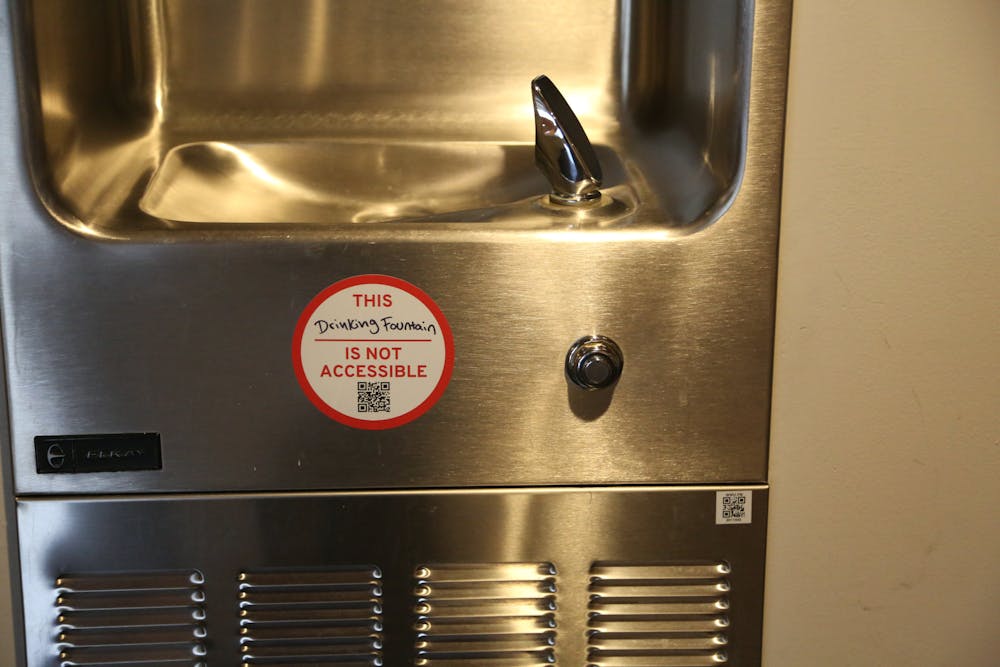While navigating Western Washington University, campus community members may notice round, red and white stickers placed on certain facilities and access points. Each one is inscribed with the simple but instructive phrase “This Is Not Accessible.”
It isn’t just one person placing the stickers. This Is Not Accessible, shortened to T.I.N.A., is a student-led project that aims to bring awareness to areas on campus that aren't inclusive to students with physical disabilities, all through the act of placing a sticker.
Scanning the QR code at the bottom of each sticker brings up the T.I.N.A. Linktree, which hosts several disability resources as well as the project's Instagram page. There, anyone can request stickers to place themselves via direct messaging.
“If you have an opinion on accessibility on campus, you can consider yourself part of T.I.N.A.," said Isabel Hyde, a founding member of T.I.N.A. “It’s not just one person or one group, it’s a massive team effort.”
T.I.N.A. has given out an estimated 350 stickers since the project's launch in March 2024, according to Hyde. Once a sticker is placed, students will report back to T.I.N.A. with a photo of their placement, which will then be posted to the T.I.N.A. Instagram.
In March, Hyde began the project with business student Zachary Connor and several other peers in an honors seminar class titled Disability, Inclusion and Advocacy. The class’s professor, Kristen Chmielewski, invited her students to think about how they can involve themselves in disability advocacy as college students.
“[T.I.N.A.] was just something that was small, that anyone can be involved in,” Hyde said. “We were trying to ensure that being a part of our project was [as] accessible as possible to everyone.”
For Connor, T.I.N.A. is about creating conversation around inaccessibility not just at Western, but throughout Washington state. He's given T.I.N.A. stickers to an architectural firm as well as Seattle University.
“Maybe they haven’t been placed yet, but maybe they have inspired conversation around campus and around the state,” Connor said.
T.I.N.A. has posted an Americans with Disabilities Act checklist to their Instagram to help students identify inaccessible spots around campus and start placing their own stickers. The Americans with Disabilities Act, or ADA, was enacted in 1990 and prohibits discrimination against people with disabilities.

A T.I.N.A. sticker is placed on the door of the gender neutral & family restroom on the first floor of the Communications Facility building at Western Washington Washington University on May 15, 2024, in Bellingham, Wash. While the room is very spacious, the door is very heavy and has no automatic button. // Photo courtesy of This Is Not Accessible
Not all locations where T.I.N.A. stickers are placed necessarily break ADA requirements, but they also aren't inclusive to every student, Hyde said.
Ren Anderson, a Western student who uses a cane, has experienced inaccessibility at the university firsthand. They recalled a few instances last year while living in the Fairhaven Complex.
“Elevator access to the 2nd floor was limited to dining hall hours and after hours they turned off access … but frequently they’d forget to turn it on again, so I’d be stuck downstairs with no way to get food,” Anderson said. “Sometimes I tried to ask other people going up to the dining hall to take a message for me that I was stuck down there, but the people working in the dining hall couldn’t always do anything.”
Anderson was newly disabled last year and had been using their cane for just 3 months before they started attending Western.
“A lot of surviving as a disabled person in an incredibly inaccessible environment like Western is knowing how to speak up and be loud and annoying when things need to be changed, but I hadn't really learned that skill yet,” Anderson said. “I was kind of thrown headfirst into a bunch of barriers and expected to sink or swim.”
Title II of the ADA covers all publicly-funded universities, requiring them to have all programs and extracurricular activities accessible to students with disabilities.
John Dorris is the Continuing Education Coordinator at the Northwest ADA Center, an organization that assists businesses, state and local governments and people with disabilities with ADA education. He explained why many universities may still not be fully accessible.
“The most common [ADA violation] is usually going to be facility access from older universities that are still using older buildings,” Dorris said. “They may not have the accessibility features. The ADA recognizes financial constraints and sometimes it’s just not feasible to make an architectural change.”
There are three areas on campus that T.I.N.A. has deemed their ‘successes,’ or places that have been acknowledged by the university and changed since the placement of a T.I.N.A. sticker. In one of these successes, a broken but accessible water fountain in the Wade King Recreation Center was fixed within a week of having a sticker up.
“We are very aware that change won’t happen just because we put up a few stickers,” Hyde said. “So what we’re really trying to do is build this community to ensure this conversation continues and continually ask why this is important.”
Sean Lynch (he/him) is a campus news reporter for The Front this quarter. He is a third-year visual journalism major. Outside of reporting, Sean likes skateboarding, reading and playing kendama. You can reach him at seanlynch.thefront@gmail.com.






